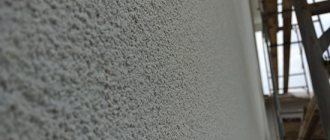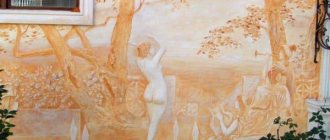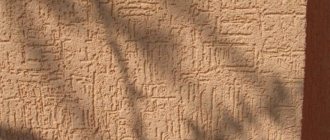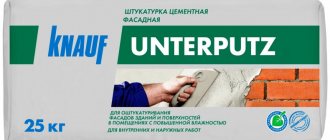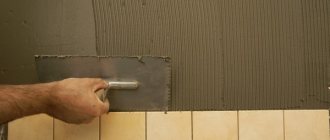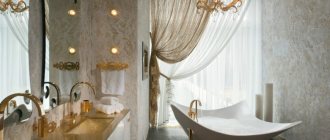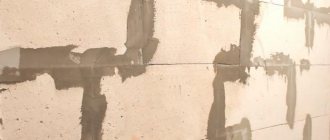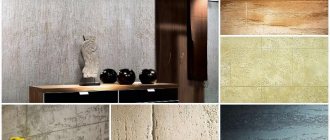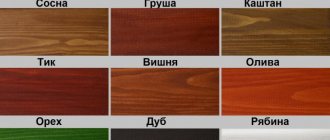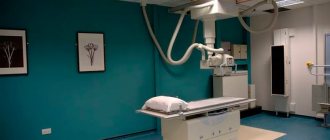The types of plaster for facades are extremely numerous, and each of them has its own unique properties and characteristics that help decorate almost any type of wall. The main purpose of any type of plaster is a high-quality and aesthetic finish. Another useful aspect of this building material is that it is able to qualitatively protect walls from the harmful effects of nature: rain, snow, heat or cold. You should choose the material based on your own preferences, as well as the conditions in which the house is located.
- The main type of facade plaster
- Variety of textures of plasters for facades
- Plaster bark beetle
- Pebble plaster
- Mosaic plaster
- Lamb plaster
- Types of facade plaster compositions
- Types of applying plaster mixture
- Advantages of facade plaster
- Disadvantages of facade plaster
- Tips for choosing plaster for facades
The main type of facade plaster for finishing houses
Although there are many types of facade plaster, the most important among them is still wet plaster. It has very attractive visual qualities and also reliably protects the walls from unwanted environmental influences. The most important advantage is increased resistance to ultraviolet radiation (the constant glow of sunlight). The principles of application are also quite simple - the wall is pre-leveled and prepared for applying plaster. After this, the surface is cleaned from dust and other contaminants.
The layers perform not only a decorative, but also a protective function, as mentioned earlier. They are applied alternately, and the protective layer also has a very attractive and presentable appearance, due to which it does not require additional finishing with other building materials. The abundance of colors and textures will amaze every person who wants to make their own home more original. In the process of repair and construction, it is simply impossible to do without facade finishing.
Installation and finishing work
Each type of exterior plaster requires different application methods. However, the process sequence is basically the same:
- Before applying plaster, the surface requires preparation. Sometimes special beacons are used so that the building acquires the necessary harmony.
- If bark beetle is used, then the wall is pre-insulated with foam plastic or other heat-insulating material.
- The solution is applied from top to bottom, as it tends to float under its own weight. As it floats, the solution must be pulled up.
Applying facade plaster
At the final stage, the façade is given texture, shaped protrusions are made, a “fur coat” is applied, etc.
It is worth noting that during the application of any solution and the period of its hardening on the facade, it must be protected from external influences. There should not be a break between applying the solution, so all work should be clearly planned.
Variety of textures of plasters for facades
Texture is an aesthetic point that has absolutely no effect on the service life and quality of the product. Each type of texture has a unique manufacturing method, since the process of its production uses raw materials that have a certain granularity of filling. A more abstract gradation of textures is divided into classical and modern, but in reality there are many more types, which we will talk about in more detail below. Classic compositions are the most proven, and they still do not lose their relevance. Modern models are distinguished by a recycled composition, which, as a rule, is of higher quality, but has a higher price.
Facade plaster - types of texture
Facade plaster, types of textures - this is the same multifaceted area in matters of analysis of this type of material for the design of external wall surfaces. There are several main types:
- Bark beetle
- Mosaic
- Barashkovaya
- Kameshkovaya
Types of material
Like most plasters, bark beetle can and should be divided into several types. The division is based on the basis of the mixture and grain size. It depends on them what the final pattern on the surface to be coated will be.
Therefore, when purchasing a mixture, you should pay attention to both indicators, since if you choose the wrong base and grain size, you will not be able to obtain the desired effect
Based on the type of base, both facade bark beetle plaster and the mixture intended for interior work are divided into the following types:
- . gypsum - the cheapest option for interior work;
- . acrylic - used for both interior and exterior work, has increased adhesion to the surface;
- . silicate - used for interior and facade work on surfaces such as brick, concrete and applied to non-permanent surfaces (with the exception of foam plastic).
- . silicone-silicate - ideally combines all the best from both types of base. Has high dirt-repellent ability. The consumption of such bark beetle plaster is lower compared to others.
The grain size in the bark beetle varies from one and a half to three millimeters, and this determines whether the plaster will be more or less textured. Which indicator will be optimal for a particular case should be decided immediately. To do this, it’s good to refer to the photo of bark beetle plaster with different grain options.
In addition to this division, some companies may have their own gradations for the material, and a conscientious seller must certainly inform the buyer about this.
Decorative plaster for facade - bark beetle
Each type requires separate consideration, so we will start with a discussion of plaster with a bark beetle texture.
Methods for applying bark beetle to facades
It is bark beetle plaster that has the greatest abundance of application variations, due to which it has become one of the most popular in the field of finishing work. Traditionally, this plaster is applied:
- Vertically
- Using a spatula in a circular motion
- Horizontally
- Crosswise
Fans of a more creative approach will appreciate the wave-like principle of application, and they can also come up with their own version. Everything is limited only by the imagination of the creator, as well as the sense of taste. The relief is formed using the technique of grouting with a plastic float. The pattern will depend on which direction you rub the solution.
Plastering works
How to plaster a facade with your own hands? Here are the instructions. Quite general: each type of plaster has its own characteristics, which are usually listed by the manufacturer on the packaging.
- Work begins only after the building has completed shrinkage. Waterproofing, roofing work and communication wiring must also be completed. Otherwise, the appearance of cracks in the plaster is inevitable.
- Before work begins, the facade is thoroughly cleaned of dust, grease, salts and other materials that will impair the adhesion of the decorative layer.
- In dry, hot weather, the surface under the plaster must be moistened.
- Vertical deviations of the wall under plaster should not exceed 10 millimeters per floor of brick walls. For the entire height of the building, the permissible deviation is no more than 30 millimeters.
- Horizontally, the wall should have a curvature of no more than 15 millimeters per 10 meters of length.
Attention:
These are the current standards for apartment buildings. Owners of private housing should not worry about these standards: they are more related to the safety of the building, and not to the beauty of the facade.
With a high building height, any deviations from the vertical are extremely dangerous. Imagine plaster falling from a height of three tens of meters... Plastering with cement, lime and cement-lime plasters is carried out in three stages:
- Spray - the first layer up to 5 millimeters thick. After application it rubs off.
- Soil is the second layer, up to 8 millimeters thick. After application it is leveled too.
- Covering is the top layer of plaster on the facade, having a thickness of up to 2 millimeters (when using structural plaster - up to 7 mm).
Acrylic and silicone putties are spread on surfaces previously primed with a primer in a layer of no more than five millimeters at a time. The tool is a wide spatula. On unstable surfaces (foam plastic, mineral wool), the surface is reinforced with fiberglass mesh.
Plastering over insulation is no longer typical only for private housing construction.
Pebble plaster for facades
Pebble plaster is the next type of material in terms of texture. This tool is universal in creating a textured pattern on the outer part of the walls. Using this material, you can easily develop unique patterns that will harmoniously decorate your home. The texture can be very diverse: bas-reliefs (small and large), the now popular “sgraffito”, “fur coat”, “polka dots” and so on. This plaster contains a special crumb, which has a fraction of 1-3 mm.
Structure, again, is imparted through the use of the already familiar plastic grater, which is used to rub the material applied to the wall. You can also use special brushes, rollers, trowel-type tools and palette knives for application. In the process of forming patterns, a variety of spatulas are used, which help to scratch the plaster, smear it in different directions, imprint textured patterns, and distribute textured elements invented by you. You can also draw on this plaster a variety of patterns that just come to mind.
Structure and colors
Thanks to the possibility of creating a textured surface, a number of important issues are resolved:
- Thanks to the uneven texture, small cracks become invisible, and such a surface can withstand stress better than a smooth one;
- Based on decorative purposes, you can choose reliefs that look and feel different.
There are three most common types of structures:
- "bark beetle";
- "lamb";
- "fur coat".
The first type got its name due to the fact that after applying the mixture to the prepared walls and drying, the effect appears as if the surface had been eaten away by a bark beetle. This is achieved due to the fact that the material contains special fractions with a diameter of 1.5-2 mm, which form characteristic grooves at the time of grouting.
This type of mixture has a finishing purpose and was created for external finishing work, but due to its excellent utilitarian qualities it is often used for cladding the internal walls of industrial premises.
The “lamb” structure is formed thanks to small rounded pebbles made of dolomite, marble and quartz. This decorative material is applied with a special construction trowel or roller, which allows the mixture to be distributed evenly.
The surface of the walls on which the “fur coat” plaster is applied has a pleasant roughness and graininess. It contains dolomite chips up to 3 mm in size
It is important that the applied layer does not exceed the thickness of the fraction size. The required structure can also be achieved using a roller or trowel soaked in water.
Sometimes mica is added to the composition. This mixture with sparkles shimmers in bright sunlight, greatly enlivening the composition.
Mosaic plaster for facades
Mosaic plaster is an exceptional option because it must be applied in an even, transparent layer, thereby achieving a mosaic effect. In the composition you can easily see large granules of stone chips, as well as an abundance of particles of various mineral rocks. Another feature of this type of material is the natural origin of each filling element. If we talk about the aesthetic point of view, then this type is the most noble in terms of texture.
The application principle is extremely simple. Initially, the plaster is applied to the wall in one layer, after which it is carefully rubbed until smooth. This material is given its characteristic transparency using silicone or silicate binders. In this case, the treated surface does not need to be additionally decorated with anything else (varnishes, paints and other protective elements).
Gypsum and cement based plaster
How to decide which is better: cement plaster or gypsum plaster? It is difficult to answer this question unambiguously, since each material has its own scope of application.
Cement plaster is usually applied when a strong and durable base is required. The composition of such a mixture includes cement, lime, water and sand. The main advantages of cement plaster are:
- high strength;
- excellent adhesion to various types of surfaces;
- affordable price;
- resistance to moisture, temperature changes, and sunlight.
One of the disadvantages of cement-based plaster is its limited scope of application - the solution cannot be applied to plastic or painted substrates. The process of applying plaster is quite labor-intensive; it includes spraying, leveling and grouting the mixture. The period of complete hardening is quite long, it ranges from 7 to 14 days.
To understand which plaster is better - gypsum or cement, you also need to familiarize yourself with the features of the gypsum mixture. This finishing material has many advantages:
- shrinkage is excluded, the surface will be perfectly flat;
- the solution is non-aggressive and environmentally safe;
- the gypsum composition is plastic and easy to apply;
- the treated surface has low thermal conductivity, the walls will be warm to the touch;
- complete hardening occurs in 3-7 days.
The only disadvantages of gypsum plaster include its high cost (compared to its cement counterpart) and the impossibility of performing external work.
By what criteria is it assessed which gypsum plaster is better: Knauf Rotband, Unis, Bergauf or Osnovit? All of the listed brands are of decent quality, so it is recommended to choose a composition based on its characteristics. The following parameters are important: application thickness, solution lifetime, fraction size, adhesion strength to the base.
Plaster "lamb/fur coat" for facades
Lamb plaster, which was popularly nicknamed “fur coat”, is the 4th type of finishing coating for facades. The characteristic formation of texture is carried out using the casting technique, which does not require further grouting. Due to the ease of application, this material has become especially widespread in our country. To form the relief, additional cement-lime or cement-sand mixtures are almost always used.
So, we figured out what types of plaster there are. But this gradation is far from the only one, since the material also differs in its composition.
How to choose?
When choosing plaster, you should take into account the climatic conditions of the building, its purpose, and the type of working base.
To provide additional heat to the building, pay attention to compositions containing foam glass, perlite, and vermiculite. In regions with high humidity, the moisture-resistant characteristics of the plaster should be maximum
The so-called “winter” or frost-resistant version is optimal for northern regions. For those who want to repair the facade as rarely as possible, acrylic (service life is up to 25 years), silicone and silicate (service life is 15-20 years) compositions are suitable. Cement compositions have the least durability; their service life is 10 years.
Long-term preservation of functionality and aesthetic appeal is associated with the texture of the plaster
Smooth and smooth surfaces are more susceptible to cracking, while rough ones are not only more durable, but also hide minor surface imperfections. When purchasing plaster, it is important to understand how well it matches the type of wall. Otherwise, even an expensive and high-quality composition will not fulfill its functions.
So, for brick it is better to use cement or silicone compounds, and for aerated concrete - silicate or silicone. For the frame structure, choose an elastic acrylic mixture. Wood will accept silicate plaster well, and it is recommended to apply acrylic plaster on top of the reinforcing mesh on insulation boards.
In addition, when plastering a wooden building, you will need to ensure the presence of a special mesh with large cells or a shingle frame. Cement mortars are universal - suitable for all types of walls, including cold and damp basements. If installation is intended on the surface of the insulation, a reinforcing mesh is first laid.
All plasters are divided into 2 types:
- thick-layer – silicate and cement mortars;
- thin-layer – these include acrylic and silicone containing mixtures.
The use of the latter type of solution requires careful preparation of working substrates - cleaning, leveling.
The ready-made mixture is more convenient to transport and use (there is no need to calculate the ratio of parts of the composition and water, or mix the solution), but it is more expensive than dry mixtures. In addition, this form is not possible for all types of plaster.
Finishing with plaster can be an expensive pleasure, so always take into account the material consumption per 1 square meter. m. This will help not only to get an idea of the total cost of the mixture, but also to correctly calculate its required volume.
In general, consumption consists of factors such as the type of filler and binder, as well as the type and evenness of the working base.
On average, for different types of plaster the consumption is as follows:
- acrylic-based compositions – 1.5-3 kg/m2;
- silicone compounds – 2.5-3.9 kg/m2;
- mineral plasters – 2.5-4 kg/m2.
Having calculated the volume of material required for work, add another 5% to it. These are the so-called working losses. In the absence of such an increase, you risk finding yourself in a situation where there is not enough mixture and you have to buy more, selecting the desired shade. In this case, construction will be suspended.
When choosing a material, not only its functional but also its aesthetic characteristics are important. It is logical that users want the color to last as long as possible.
The durability of the color coating is determined by several factors:
- paint is applied over the plaster or color pigments are dissolved in the composition (the second option is preferable);
- antistatic properties of plaster, which determine the degree of surface contamination;
- resistance of color pigment to precipitation and UV rays.
The best result, based on the parameters discussed above, is demonstrated by silicone plaster. It does not attract dust, does not fade and is also characterized by a rich color palette. It is slightly inferior to silicate plaster, which cannot boast of such a variety of shades. Acrylic solution is subject to fading, in addition, it quickly becomes dirty. The worst indicators of color durability are demonstrated by mineral and cement coatings, which require almost annual painting.
Types of facade plaster compositions
The compositions can be separated into a special list, after reading which it will be easier for you to choose the appropriate material for your own home:
- Cement composition It is best suited for the formation of special textured patterns and original patterns. Supplied as a dry mixture similar to powder. In addition to cement, this product includes a mineral filler, as well as various modifiers. The thickness of the layer after application is about 2-5 mm. Among the properties, the wear resistance and ductility of the material deserve special attention.
- Acrylic plaster The product is supplied ready-mixed. Pebble and traditional reliefs are obtained of the highest quality with this type of plaster. The product contains acrylic resin, modifiers, and a special sand filler. The thickness of the applied layer is 3-4 mm, and this type of material is characterized by increased wear resistance and adheres well to the surface
- Silicate plaster is also sold in the form of an already prepared mixture, which includes modifiers, silicate binding materials, which are better known as “liquid glass”. This product is suitable for making absolutely any type of texture, and the layer thickness is only 4 mm. This plaster becomes an ideal option for houses that are installed in conditions of high humidity.
- Silicone plaster, as you might guess, is also sold in the form of a ready-made solution. It is universal for any type of finishing work and textures, and its composition includes emulsifiers, modifiers, a silicone binder and mineral filling. Layer thickness – 3-4 mm. Such plaster is almost impossible to damage with impacts; it also adheres perfectly to any type of surface, has antiseptic properties, and has high elasticity.
Types of plaster for exterior use
Binders, sand, liquid glass, and acrylic resin are added to the material for finishing facades. These substances make it plastic, frost-resistant, and prevent cracking.
- Leveling plaster, which is used for rough finishing of walls.
- Special plasters contain fillers that enhance their functional qualities. When making a heat-insulating mixture, foam glass, polystyrene foam, and foamed perlite are added. The waterproofing mixture contains bitumen, crumb rubber, epoxy and acrylic resins, and latex. Pumice chips, expanded clay, and aluminum powder are added to soundproofing plaster.
- Decorative plaster is used for finishing the facade and gives the building a complete aesthetic appearance and expressiveness. They are produced in different colors, composition, texture. Venetian after hardening resembles marble, and stone resembles natural stone masonry.
Depending on the method of application to the facade, decorative plaster is divided into:
- Dry – slabs based on cement particle board,
- Wet - applying a layer of the mixture and then drying.
For construction teams, the cost of plastering facades is determined by calculating the price per 1 m2 and ranges from 350 to 550 rubles. If you follow the coating technology, you can do this work yourself.
Types of applying plaster mixture
- Manual type This plaster is applied using spatulas, rollers, brushes and other tools
- Mechanized type This material is applied to the wall using electronic devices (best suited for extensive work)
- Universal type This plaster can be applied both by hand and with technical devices
Wet plaster method
A well-known method of plastering walls. First, a primer is laid on the wall, then insulation and reinforced mesh. After this, the plastering process itself begins. This technology is good because it eliminates condensation, creating a warm and dry living space.
As insulation, you can choose polystyrene foam, OSB boards or mineral wool. These materials are resistant to moisture and have good thermal insulation.
Since many amateurs want to start decorating walls with plaster on their own, it is worth cautioning against errors in its dilution. The best way for non-professionals is to buy a ready-made mixture. It is convenient to store and transport.
There are types of plasters that can only be applied by professionals. If you want to create a complex pattern, it is better to contact experienced builders and look at photos of facade plaster on the Internet. For many, facade plaster has become a durable, inexpensive, and stylish way to cladding a house.
Advantages of facade plaster
- Aesthetic beauty
- Light weight Light weight of the applied layer
- Ease of application Application work can be carried out without the involvement of specialists
- Good thermal insulation
- Frost resistance
- Easy to clean The façade is easy to clean and clean
- Fire resistance
- Environmental friendliness, environmental friendliness of material production
Bayramix (Bayramix)
The Bayramix brand belongs to the Russian group INTERRA DECO GROUP and has been known since 1993.
The company specializes in materials with the addition of marble chips. The product line of decorative plasters is represented by mixtures for creating a marble coating with particles of different fractions, textured, including elastic, thin-layer, as well as materials with the addition of colored chips - more than 20 types in total. More than half of the mixtures have universal characteristics and are therefore used for interior and exterior decoration. Characteristics of Bayramix decorative plasters
| Characteristics | Mineral (fine fraction) | Colorix | Teratex |
| Application area | For interior and exterior finishing of any mineral substrates, as well as plasterboard, chipboard, fiberboard. The composition is designed for application to surfaces subject to abrasion and contamination. Apply in 1 layer. Available with filler of 3 fractions. 52 color options available. | For interior use only, to be applied to any type of prepared substrate. Apply with a roller or spray gun in 1 layer. Contains colored chips (flocks). The finished coating is resistant to washing and abrasion, and can be easily restored. 27 colors according to the catalogue. | Modeling composition for interior and exterior use and application to any type of hard substrate. Apply in 1 layer with a roller or spray gun. The base color is white, computer or manual tinting is available. The finished coating is durable, hides minor defects in the base, and is resistant to washing and abrasion. |
| Decorative effect | Mosaic covering. | Rough mosaic covering. | Fur coat, mud coat, crinkled fabric, effects using stencils. |
| Delivery option | A paste-like mixture to which you add water. | Ready mixture. | |
| Packing | Bucket 25 kg. | Bucket 4.5 or 9 kg. | Bucket 15 or 25 kg. |
| Compound | Water, marble granulate, acrylic polymer, modifiers. | Water, acrylic polymer, colored chips, mineral filler, modifiers. | Water, acrylic polymer, mineral additives, modifiers. |
| Consumption, kg/m² | 1,5-2 | 0,3-0,5 | 2-2,5 |
| Price, rub./kg. | 128 | 480 | 86 |
| Cost of 1 m² of coverage, rub. | 192-256 | 144-240 | 172-215 |
Impressions from use. Many Bayramix decorative plasters are applied in one layer and require a minimum of skills. Those. suitable if you decide to save on workers and do the repairs yourself. The main thing is to properly prepare the base, and use the compositions of the same manufacturer for this. This is a budget option for finishing facades or high-traffic areas, for example, in administrative buildings, corridors, etc. Durable, without any special decorative frills.
Video about Bayramix marble plasters and their application:
Disadvantages of facade plaster
- Low mechanical strength
- Labor intensity in the process of finishing work
- Seasonality in the process of repair and application of plaster (it is recommended to carry out procedures at temperatures from +5 degrees Celsius)
- Expensive
Do-it-yourself technology for plastering external walls
First, let's look at how to level and prepare external walls for applying decorative finishes.
Preparing the surface of the building facade
- Remove old finish.
- Clean the walls with a stiff steel brush.
- Inspect the surface to identify cracks and dents (roughness on the wood, burrs), etc. If there are any, clean them with sandpaper.
- Wash the wall with a damp sponge (with soap if necessary) and dry.
- Use a plumb line or level to check the verticality of the walls.
It is recommended to impregnate wooden facades with an antiseptic solution. If the walls are made of brick, stone, or aerated concrete blocks, then use empty masonry (with incomplete filling of the seams on the front side). This will ensure better adhesion of the wall surface to the plaster. If this has not been done, then before plastering, jointing is carried out (the seams are deepened with a chisel and hammer by 1 cm and cleaned with a brush). On concrete walls, with an ax or perforator, notches are made with a depth of 5 mm and a length of 5 to 10 cm in increments of no more than 4 cm.
jointing and notches for plaster
To improve the adhesion of the plaster to the surface of the facades, a primer is first applied. Its composition is selected taking into account the nature of the wall surface (concrete, wood, brick, etc.). The primed walls are left to dry for a day.
How to plaster: stages of applying a leveling layer
To obtain a good result, the plaster mixture is applied in three layers:
- Spray (starting) - from 3 to 9 mm (depending on the nature of the surface, a thicker layer is needed on wood).
- Ground - from 7 to 8 mm, if the plaster contains gypsum, then 9 - 12 mm.
- Covering (finishing) - from 2 to 4 mm.
To strengthen the facades and ensure rigid adhesion of the leveling layer, the plaster mixture is applied to the reinforcing mesh. To do this, after the primer has dried, apply the first layer of plaster and embed the mesh in it. Wooden facades can be reinforced with the same mesh or shingles - narrow wooden slats nailed diagonally crosswise. If the walls are insulated with mineral wool or similar insulation, then an adhesive solution is applied to it to fix the mesh. For example, ARMIERUNGS-GEWEBEKLEBER 215, PALADIUM PalafiX 402, Glims KF and others.
The procedure for plastering facade technology:
- The reinforcing mesh is installed on the street wall or on the insulation.
- If necessary, guide beacons made of metal profiles are attached. They are fixed to the wall with plaster mortar, and verticality is checked with a level.
- Apply the plaster mixture with a spatula or paint bucket, starting from the bottom and gradually moving upward. With the machine plastering method, a compressor and a pneumatic bucket are used for this.
- The applied layer is leveled using the rule. When using beacons, the rule rests on two guides and rises up, leveling the plaster layer.
- The second layer begins to be applied after a day. On the fresh layer you need to make notches or grooves to ensure better adhesion to the finish. You can use a notched trowel for this.
- After another day, apply the last layer - the covering. Dilute the plaster for it to a creamy consistency.
- After the finishing layer has dried, use a special trowel to grout. Press the device tightly against the surface, making circular movements clockwise. After processing the entire facade, rub it again in a straight line. If you need to achieve a perfectly flat surface, then wrap the grater in felt or felt.
Grout
If the decoration of the facade is carried out on the basis of leveling plaster, then immediately after applying the last layer, without waiting for it to dry, they begin to create a pattern or relief.
To do this, use special rollers with patterns, stencil stamps or a trowel. Options for drawings can be very diverse. Stamps are not very convenient, since they have to be washed frequently, and the expression of the design in different places is not the same due to different pressure forces. With a trowel, you can create a stone texture on the wall by simply making chaotic movements with it. If the plaster is planned to be painted, then after creating the texture and drying it is primed again and after that the paint is applied.
Tips for choosing plaster for facades
- For beginners, it is better to choose ready-made mixtures
- Silicone solution is the most durable
- To save time, use a ready-made colored solution
- Consider the type of application surface in advance
- Be sure to choose models with instructions for use
- Don’t skimp on cheap analogues of proven materials
- Buy a quality tool for finishing work
- Choose the color of the product you buy wisely to get the desired result.
Scope of application
Plastering is used both for external decoration of walls and for rooms. For example, the silicone mixture is waterproof, which means it can be used as a decorative structural plaster for exterior and interior use - in the bathroom, kitchen. In rooms, a fine-grained fraction is used to create a beautiful roughness effect. A wide palette of plaster colors allows you to create a unique room decor. Before buying material, you need to know how much is needed for finishing. To calculate the required amount, you need to multiply the plaster consumption by 1 m2 by the area and by the required number of layers. Average consumption per square meter is 2 kg. There are different brands and manufacturers of structural plaster. The most famous names of them:
- Olimp;
- Alpina (Alpina) – r20;
- Ceresit ct 137, st-36– Ceresit;
- Expert (Expert);
- Bayramiks;
- Dufa modellierputz;
- VGT;
- Knauf;
- Mineral decor – Mineral decor;
- and others.
Structural plaster in the interior
In stores, the material can be bought dry in bags or bags. In liquid ready-made form it is sold in buckets. It is most often sold in buckets of 10 liters, in bags - 16 kg and 18 kg. Prices for structural plaster depend on the manufacturer. It is better to choose according to the principle - price-quality. The cooking method, instructions and proportions are always indicated on the label. Liquid ready-made mixtures only need to be colored. Dry mixtures require water and glue or soap. The mixture is first stirred in water, and only then soap or glue is added.
History and modernity
Plaster appeared so long ago that even experts who dig in the dust of centuries find it difficult to name the exact time of its “birth”. Apparently, the first experiments in applying a solution of clay, sand and water were made by primitive man, trying to plug the cracks in the wall of the cave through which there was a blow into his home. Over the long period of its existence, facade plasters have not changed much. It is still a mixture of filler, binder, water and plasticizers. Clay, gypsum, lime, and cement are used as a binder for preparing the plaster composition. With the development of chemistry, polymer-based plaster solutions appeared that have higher protective properties, for example, from moisture.
Since ancient times, sand or mineral dust has been and continues to be used as a filler for plaster composition. With the development of progress, the most significant advances have occurred in the composition of plasticizers for solutions. Today it is difficult to find a plasterer who adds natural ingredients to the solution to give it certain qualities (increasing plasticity, moisture resistance, frost resistance, etc.) - egg yolks, cottage cheese, whey, bovine blood or urine, vodka or something similar.
Although, hand on heart, it is difficult to find a craftsman who, if he needs plaster for facades, will distinguish fluff lime from boiling water. And about the process of preparing the solution itself, he knows something more than “pour the required volume of cold water into a plastic container, pour in the dry mixture and mix with a mixer until a homogeneous mass is obtained. Leave the mixture for five minutes and stir again.” Often, preparing a plaster mixture generally comes down to opening a sealed plastic container labeled “facade plaster.”
Let’s not grumble about how big and high-quality the trees used to be, and what excellent decorative qualities the blue sky had, but now everything has become smaller and faded, although not without it. Let's look at what materials are offered in the “plaster for facades” section.
Advantages and disadvantages
It is impossible to say unequivocally that all types of material have the same advantages or disadvantages - it all depends on the composition, purpose and properties of the plaster, but some features can be highlighted.
Advantages:
- Ecological cleanliness. Thanks to the use of natural, non-toxic ingredients.
- Fire resistance. The coating does not burn and does not contribute to maintaining the combustion process.
- Easy to use. The façade of the building is easy to repair and clean.
- Frost resistance.
- Thermal insulation. Provides heat conservation in the room.
- The work can be done manually, or without the involvement of specialists.
- Aesthetic beauty.
- Modest weight. The weight of the plaster is very small, so additional repair work and strengthening of the foundation are not required.
Flaws
- Low mechanical strength. Low resistance to mechanical stress is possible if reinforcing mesh was not used and facade plastering technology was not carried out. Then chips and cracks may appear on the surface of the building.
- Labor intensity of installation work. The complexity lies in the need to strictly follow the recommendations for applying the mixture and professionalism. Creating an invoice takes a long period of time.
- Dependence on seasonality forces us to focus on a temperature regime of at least +5 degrees, which limits the timing and possibilities of repair work. If this requirement is not met, the applied solution will take a long time to dry and will not adhere well to the base.
- The material is expensive - the cost of decorative plaster is higher than regular plaster.
Return to content
